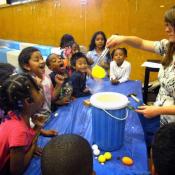Community Resources for Science
Impact
Community Resources for Science (CRS) offers engaging hands-on science opportunities to roughly 1,100 elementary school educators and 25,000 students at more than 100 urban schools in San Francisco’s East Bay. Vast majorities of participating teachers say CRS has helped them teach more science, teach it better, and get their students excited about science. With extra support, CRS could reach thousands more students in the next three years.
Accomplished
- Need Accomplished
- Evaluation Developing
- Sustainability Accomplished
- Replication & Scalability Developing
- Partnerships Accomplished
- Capacity Accomplished
- Challenging & Relevant Content Accomplished
- STEM Practices Accomplished
- Inspiration Accomplished
- Under-Represented Groups Accomplished

CRS trains employees to work well with teachers, manage an elementary school classroom, and make a big impact with students in just a one-hour presentation…. They’re effective team-builders, either with employees who already work together or across departments. CRS does a good job of taking pictures, getting quotes from happy teachers and volunteers, providing reports that make it easy to keep up a dynamic internal communications campaign throughout the year.”
Manager, Public Policy & Communications, Bayer HealthCare
Design Principles
The programs in this database clear a high bar. STEMworks reviewed each program against the Design Principles for Effective STEM Philanthropy. Programs must be Accomplished () across all Design Principles, or be Developing (
) in a maximum of three areas.
Overarching Principles
-
Need Accomplished
Identify and target a compelling and well-defined need.
-
Evaluation Developing
Use rigorous evaluation to continuously measure and inform progress towards the compelling need identified.
-
Sustainability Accomplished
Ensure work is sustainable.
-
Replication & Scalability Developing
Demonstrate replicability and scalability.
-
Partnerships Accomplished
Create high impact partnerships.
-
Capacity Accomplished
Ensure organizational capacity to achieve goals.
STEM Principles
-
Challenging & Relevant Content Accomplished
Offer challenging and relevant STEM content for the target audience.
-
STEM Practices Accomplished
Incorporate and encourage STEM practices.
-
Inspiration Accomplished
Inspire interest and engagement in STEM.
-
Under-Represented Groups Accomplished
Identify and address the needs of under-represented groups.
Program Overview
CRS connects and engages educators, students, and scientists in a vibrant and innovative web of science learning resources. Our goal is simple: help K-5 teachers give students more opportunities to “do science” – to ask questions, test ideas, get their hands on real science activities. Since 1997, CRS has developed an innovative set of information, support, and connection resources that increase the amount of science taught in K-5 classrooms. CRS provides timely information, personalized planning support, and in-class, scientist-led presentations, working directly with classroom teachers to meet their unique needs and increase their skill, confidence, and access to information and useful resources. We help teachers plan activities to meet a particular science standard, find field trips to a museum or outdoor education center, or connect them with the resources they need. Coupled with the information and on-call support, our scientist-volunteer-in-the-classroom program (BASIS) brings over 400 diverse, enthusiastic scientist teams into classrooms to do science and to talk about science as an exciting career. Teachers value the in-class professional development they receive from the scientists and say they see particular students engaged and succeeding at levels not observed with traditional instruction practices.
Funders and Partners
University of California, Berkeley, Department of Chemistry; Science@Cal; CalTeach; Environmental Leadership Pathways, UC Berkeley, College of Natural Resources; Gateways STEM Network; Bayer; Clorox; Oakland Unified School District; Berkeley Unified School District; Berkeley Public Education Foundation
